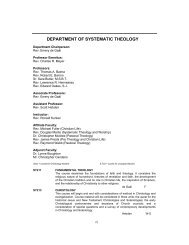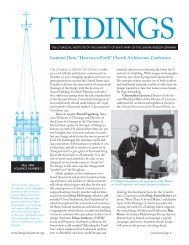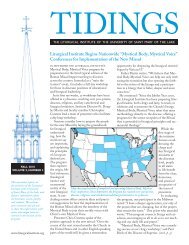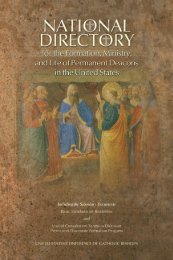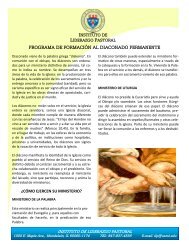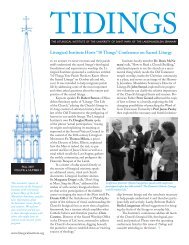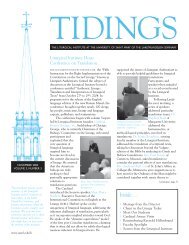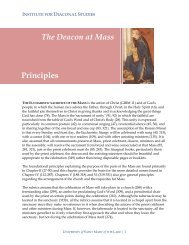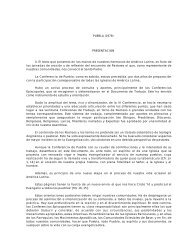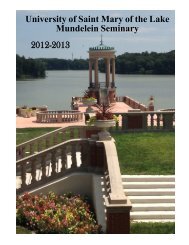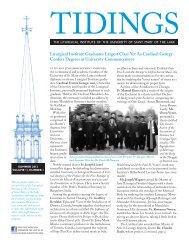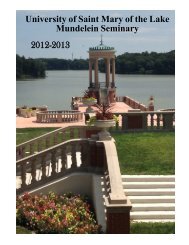Volume Nine, Number 2, Summer 2010 - Mundelein Seminary
Volume Nine, Number 2, Summer 2010 - Mundelein Seminary
Volume Nine, Number 2, Summer 2010 - Mundelein Seminary
Create successful ePaper yourself
Turn your PDF publications into a flip-book with our unique Google optimized e-Paper software.
TIDINGS<br />
the liturgical institute of the university of saint mary of the lake<br />
Institute’s Tenth Anniversary: Education, Prayer and Celebration<br />
SUMMER <strong>2010</strong><br />
VOLUME 9, NUMBER 2<br />
This newsletter reports on<br />
the activities of the Liturgical<br />
Institute of the University<br />
of Saint Mary of the Lake and<br />
features information about<br />
the Institute’s events, faculty,<br />
and students. We welcome<br />
your comments and ask you<br />
to share this information with<br />
others who might have an<br />
interest in the mission of this<br />
program.<br />
www.liturgicalinstitute.org<br />
on july 7th the liturgical institute celebrated<br />
its tenth anniversary with alumni and<br />
friends of the Institute joining current students,<br />
faculty and staff for the festivities. Guests represented<br />
six countries and the breadth of the<br />
United States. In part a reunion of friends, the<br />
day also included education, prayer and celebration.<br />
After sung Morning<br />
Prayer, guests were treated<br />
to a special preview of the<br />
Mystical Body, Mystical<br />
Voice workshop, a program<br />
to prepare people for the<br />
CELEBRATING<br />
TEN<br />
years<br />
implementation of the third<br />
typical edition of the Roman<br />
Missal. The Institute<br />
will offer the program at<br />
over 40 locations across the<br />
nation in coming months.<br />
Mr. Christopher Carstens,<br />
Director of the Office of<br />
Worship in the Diocese<br />
of LaCrosse, and Rev.<br />
Douglas Martis, Institute<br />
Director, co-presented the<br />
workshop.<br />
Carstens and Martis explained<br />
that the sacramental<br />
nature of the liturgical rites<br />
is a key to an appreciation<br />
of the new Missal. The<br />
2000-<strong>2010</strong><br />
opening session, “Preparing a Fertile Ground,”<br />
reviewed the theological and catechetical principles<br />
underlying the translation of the new Missal.<br />
The second session, “And the Word Was God,”<br />
highlighted the deep Christological significance<br />
of sacramental words, providing a summary of<br />
the motivations of the Liturgical Movement.<br />
The third session, “And the Word Was Made<br />
Flesh,” focused on specific changes anticipated<br />
in the forthcoming translation. The final session,<br />
“The Meaning of All these Signs is Christ,”<br />
placed the discussion in the context of Christology.<br />
With Christ as the paradigm, liturgy is a<br />
dialogue, or “Dia-Logos,” as Carstens called it.<br />
Following the workshops, Mass was celebrated<br />
with Bishops James S. Wall of Gallup, and<br />
Joseph M. Siegel, Auxiliary Bishop of Joliet. In<br />
addition to the English chants proper to the day,<br />
Jaccovacci’s Te Deum was sung by the Liturgical<br />
Institute <strong>Summer</strong> Schola, under the direction of<br />
Ms. Linda Cerabona.<br />
The day concluded with a dinner, awards<br />
ceremony and reception. Honored<br />
guests included Monsignor<br />
James Moroney, the<br />
first recipient of the Institute’s<br />
Spiritus Liturgiae Award.<br />
Also honored with Founder’s<br />
Awards were Cardinal Francis<br />
George, omi, founder of the<br />
Liturgical Institute; Monsignor<br />
M. Francis Mannion<br />
the first Institute Director;<br />
and Dr. Denis R. McNamara,<br />
founding faculty member and<br />
current Assistant Director.<br />
Additionally, Bishop Wall was<br />
presented with a painting entitled<br />
“St. Paul Preaching on<br />
the Areopagus” commissioned<br />
from Leonard Porter Studio<br />
of New York.<br />
Also in attendance were<br />
Very Rev. Dennis Lyle, President/Rector<br />
of the University<br />
of St. Mary of the Lake and<br />
Provost Rev. Thomas Baima.<br />
Cardinal Francis George sent his best wishes to<br />
the gathering by letter from South America.<br />
In his address at the reception, Fr. Martis noted<br />
that one of the advantages of the Institute’s<br />
methodology is the conviction that the liturgical<br />
rites are a natural aspect of our Catholic faith.<br />
“All we need in the liturgy is already available to<br />
us,” said Martis. “Like grace, as Augustine says,<br />
it is always present, but needs to be received. We<br />
have no purpose other than the praise of God<br />
and imploring the sanctification of the world. If<br />
we are fortunate, the by product is community,<br />
engagement, nourishment. Thank you for being<br />
a part of this vision. The future of liturgical<br />
renewal is here.”
photo: Darrell Harmon<br />
Denver Archbishop Charles J. Chaput Gives Hillenbrand Lecture<br />
Archbishop Charles Chaput, OFM CAP,<br />
preaches at Mass before his Hillenbrand<br />
Distinguished Lecture<br />
as part of the liturgical institute’s hillenbrand distinguished lecture series,<br />
His Excellency Charles J. Chaput, ofm cap, Archbishop of Denver, traveled to <strong>Mundelein</strong><br />
to speak to over 100 of the Liturgical Institute’s cadre of summer participants: students,<br />
staff, faculty, members of the Sacred Music Retreat, members of the Liturgical Retreat for<br />
Priests, and visitors from the local community. He also served as principal celebrant and<br />
homilist for the Institute’s evening Mass.<br />
Archbishop Chaput entitled his lecture “Glorify God By Your Life: Evangelization and<br />
the Renewal of the Liturgy,” and began by citing the famous question raised by liturgical<br />
reformer Romano Guardini. Because Guardini “believed that the spirit of the modern<br />
world was undermining the beliefs that made this liturgical consciousness possible,” he<br />
asked if it were even possible for modern people to celebrate “the liturgical act” at all.<br />
The Archbishop then posed that same question to those in attendance, asking them to<br />
contemplate how the current American context affects our ability to understand what is<br />
true. “Let’s consider some of the evidence, “ he said. “We live in a society where the organizing<br />
principle is technological progress, conceived in narrow, scientific and materialistic<br />
terms. Our culture is dominated by the assumptions of this scientific and materialistic<br />
worldview. We judge what is ‘true’ and what is ‘real’ by what we can see, touch and verify<br />
through research and experimentation.” He then cited <strong>Mundelein</strong> <strong>Seminary</strong> professor Fr.<br />
Robert Barron who asked not that we “accommodate the liturgy to the world, but to let<br />
the liturgy be itself – a transformative icon of the ordo of God.”<br />
Chaput then offered his own commentary on the nature of the sacred liturgy. He asked<br />
first that Catholics “recover the intrinsic and inseparable connection between liturgy and<br />
evangelization,” then follow up with an understanding of the liturgy as “a participation in<br />
the liturgy of heaven, in which we worship in Spirit and truth with the worldwide Church<br />
and the communion of saints.” In speaking of the devotion of early Christians, Chaput noted that the Mass described by a group of<br />
early disciples was called a “glorious assembly” and “a heavenly liturgy” which lead them exclaim: “We cannot live without the Mass.”<br />
“This is the kind of faith that should inspire our worship,” Chaput claimed. “And this is the kind of faith that our worship should inspire.<br />
Can we really say today that we’re ready to die rather than not celebrate the Mass?”<br />
The Liturgical Institute thanks Archbishop Chaput for sharing his wisdom with our academic community. <br />
UPCOMING EVENTS AT THE LITURGICAL INSTITUTE<br />
we now offer secure on-line conference registration at www.liturgicalinstitute.org<br />
September 17, <strong>2010</strong> Mystical Body, Mystical Voice: Preview for Diocesan Representatives<br />
A preview of the Liturgical Institute’s program for liturgical renewal and the third edition of the Roman Missal. Offered for<br />
clergy and church professionals, parish and diocesan Directors of Worship, Religious Education and Deacon Formation, and college<br />
and university chaplains. The event is offered at no charge thanks to a generous grant from Liturgy Training Publications.<br />
More information and on-line registration is available at www.mbmv.org.<br />
November 5, <strong>2010</strong> Profound Preaching: Contemplative Homiletics<br />
Deacon James Keating, phd, noted presenter, educator and author, leads one of the Institute’s most popular events: a one-day<br />
workshop for priests and deacons on preaching the Word of God entitled Contemplative Preaching: Letting the Word Heal.<br />
January 21, 2011 Treasures of the Triduum with all new topics!<br />
Fathers Douglas Martis and Michael Fuller return for one of the Institute’s most popular workshops unveiling the rich theology<br />
of Holy Week. This year’s event draws from Holy Week’s Liturgy of the Hours, providing insights perfect for preachers, RCIA<br />
leaders, liturgy directors, musicians and all who desire to enter more deeply into the heart of the paschal Mystery.<br />
April 8, 2011 Mystical Body, Mystical Voice: For Church Musicians<br />
Enjoy the Liturgical Institute’s rich insights for the implementation of the third typical edition of the Missal adapted specifically<br />
for church musicians. Perfect for music and liturgy directors, priests, choir members, and all who love music and sacred liturgy.<br />
For more information call 4.3.440 or register online at www.liturgicalinstitute.org
Institute Sponsors Retreats for Priests and Church Musicians<br />
photo: Darrell Harmon<br />
Participants in the Liturgical Institute’s Sacred Music Retreat<br />
gathered for a photograph after Mass.<br />
in an endeavor to foster prayer and contemplation<br />
of the sacred liturgy, the Liturgical<br />
Institute sponsored two concurrent week-long<br />
summer retreats: one treating sacred music and<br />
the other planned for priests.<br />
Intended to combine theological and practical<br />
aspects of church<br />
music with prayer and<br />
meditation, the Institute’s<br />
fifth annual Sacred<br />
Music Retreat for church<br />
musicians was led by Fr.<br />
John-Mark Missio, an<br />
experienced church musician,<br />
composer, and former<br />
head of St. Michael’s<br />
Choir School in Toronto,<br />
Canada.<br />
The retreat theme,<br />
“Faith flows from Alleluia,”<br />
allowed a meditative journey through<br />
the Sequences that extend the Gospel Acclamation<br />
in significant moments in the Church’s<br />
year. “How fitting it is,” Fr. Missio said, “that<br />
the source of these poetic expositions of faith is<br />
found not only in the syllables of an acclamation<br />
of joy, but ultimately is found in the movement<br />
of the heart towards the Word of God.” Participants<br />
formed a retreat schola under the direction<br />
of noted Chicago composer Mr. Kevin Allen,<br />
and sang several pieces at the Institute’s Solemn<br />
Mass of the Nativity of John the Baptist.<br />
During the same week, the Institute also<br />
organized it first retreat for priests, offering<br />
meditations on themes related to the sacred<br />
liturgy. The retreat focused on priesthood and<br />
the sacred liturgy, taking inspiration from Pope<br />
Benedict xvi, who described priesthood as<br />
“The Love of the Heart of Jesus.” Retreat master<br />
Fr. Lawrence Hennessey of <strong>Mundelein</strong> <strong>Seminary</strong><br />
chose to speak on the sacred liturgy as the<br />
living spring of priestly spirituality. Centering<br />
on the mystery of Christ disclosed by the Holy<br />
Spirit in the mission of a priest, he drew from<br />
the various invocations of the Holy Spirit during<br />
the course of the Eucharistic Liturgy.<br />
Participants in both retreats joined the Liturgical<br />
Institute students for sung Lauds, Vespers<br />
and Mass each day. They also attended the<br />
Institute’s Hillenbrand Distinguished Lecture<br />
given by Archbishop of Denver, Charles J. Chaput,<br />
ofm cap.<br />
The Liturgical Institute will be sponsoring<br />
another retreat for priests in the summer of 2011<br />
entitled “Christ: The Ideal of the Priest” led by<br />
retreat master Fr. Joseph Henchey, css. <br />
Institute Awards First Spiritus Liturgiae Award to Monsignor James Moroney<br />
the liturgical institute is pleased to announce that Monsignor James<br />
Moroney is the recipient of the Liturgical Institute’s first Spiritus Liturgiae<br />
Award. This award recognizes distinguished service to the Church in promotion<br />
of her sacred liturgy. A priest of the Diocese of Worcester, Massachusetts,<br />
Monsignor Moroney was Executive Director of the United States Conference<br />
of Catholic Bishops’ Secretariat for the Liturgy from 1996 to 2007. He currently<br />
serves as Executive Secretary to the Vox Clara Committee and was a visiting<br />
faculty member at the Liturgical Institute in the summer of <strong>2010</strong>. “Monsignor<br />
Moroney has labored tirelessly for years in helping to renew the Church’s liturgy,”<br />
said faculty member and Assistant Director of the Liturgical Institute Dr.<br />
Denis McNamara. “He has taught and studied from the heart of the Church—<br />
and always accompanied by enthusiasm and good cheer.”<br />
In his acceptance comments, Msgr. James Moroney referred to the forthcoming<br />
new translation of the Roman Missal:<br />
“I thank you for this award. I am particularly humbled that it comes from such an esteemed and estimable organization as the Liturgical<br />
Institute, which in its first decade has succeeded in imbuing so many talented individuals, many of them present here this evening, with<br />
the spirit and the power of the sacred liturgy... How blest we are to be witnesses to the second springtime of the vision of the Council Fathers<br />
lived out in our own day, as we prepare to utter, in some ways for the first time, the ancient collects which define who we are and<br />
who we are supposed to be as we seek to move from ideology to worship, and from novelty to mystery, as we seek to desire not so much to<br />
change the Liturgy, as to be utterly transformed by it, as we seek to move from the prestige of being liturgists, to a recognition of our role as<br />
the very model of unworthy servants of this holy and living sacrifice.”<br />
The Liturgical Institute extends its congratulations and best wishes to Monsignor James Moroney.
Photos from The Liturgical Institute’s Tenth Anniversary Celebration<br />
July 7, <strong>2010</strong><br />
(left to right) Participants arrive for the Mystical Body, Mystical Voice preview. Institute alumnus Bishop James Wall with Institute student<br />
Deacon Thomas Foye at the anniversary Mass. Pauline Smith, Institute director of conferences and communications, welcomes guests.<br />
(left to right) The “old timers”: present and former faculty members Dr. Denis McNamara, Dr. David Fagerberg and Fr. Anthony Ruff, osb<br />
with alumni Daria Lucas Spezzano and Fr. John-Mark Missio. Institute schola sings at Mass under the direction of Ms. Linda Cerabona.<br />
(left to right) Institute alumnus Bishop James Wall serves as principal celebrant with Liturgical Institute alumni, students and guests at the<br />
anniversary Mass. Custom designed Founders Award medals on display before the anniversary dinner.
(left to right) Institute student Fr. John Paul Erickson and alumnus Fr. Joel Hastings enjoy the event. Bishop James Wall of Gallup, New<br />
Mexico, speaks to the assembled guests at the anniversary dinner.<br />
(left to right) Participants wait for the start of the Mystical Body, Mystical Voice sneak preview. Very Reverend Dennis J. Lyle, Rector/President<br />
of the University of St. Mary of the Lake/<strong>Mundelein</strong> <strong>Seminary</strong>, praises the accomplishments of the Liturgical Institute.<br />
(left to right) Institute students Alexis Janners and Julie Demerath, both parish music directors, enjoy the festivities. Dr. Denis McNamara<br />
and Bishop James Wall discuss the symbolic meaning of a painting entitled “St. Paul Preaching on the Areopagus,” a gift for Bishop Wall.
Address by Fr. Douglas Martis on the Occasion of The Liturgical Institute’s Tenth Anniversary<br />
university of saint mary of the lake, mundelein, illinois, july 7, <strong>2010</strong><br />
ten years is not a long time, and yet this first decade of the 21st<br />
century has been full. In July of the year 2000, two young men, for<br />
whom the beauty of this campus had been foreign, arrived as new<br />
pioneers, explorers on the edge of a complex ecclesiastical frontier.<br />
They immediately were seized, inspired by the vision of Cardinal<br />
<strong>Mundelein</strong>, that this place should be a center of formation for the sake<br />
of the entire Church. Through the leadership, vision, and profoundly<br />
theological intuition of Francis Cardinal George, omi that the rites<br />
of the liturgy should be studied from their long-ignored sacramental<br />
perspective, these two had the audacity to launch a new liturgical<br />
endeavor into the largely sated and settled landscape of the post-<br />
Conciliar Church.<br />
They discovered in this campus a kind of laboratory, where the<br />
values of authentic liturgical renewal could be taught, practiced and<br />
promoted. For a newly minted architectural historian, Denis Robert<br />
McNamara, this campus was a play-ground in classicism, an opportunity<br />
to merge and consociate theological ideas and their expression<br />
in brick and mortar. His academic and professional career reached a<br />
decisive moment when Providence brought him here. In his area of expertise<br />
he is unrivaled. There is no one in the United States today, who<br />
speaks more intelligently, more articulately, more convincingly of the<br />
sacramentality of church buildings and the urgent need to be thoughtful<br />
and deliberate about construction and renovation of churches. I am<br />
proud to call him colleague.<br />
For the Irish-born priest, Michael Francis Mannion, whose adopted<br />
home was the territory of Mormons, whose curriculum vitae shows<br />
him notable as pastor and rector of cathedral, as founder of the Society<br />
for Catholic Liturgy, as promoter of the Choir School of the Madeleine,<br />
as theologian, teacher and author, this endeavor was the realization<br />
of a dream to establish a school where the principles of the Second<br />
Vatican Council and genuine renewal could get a fair hearing, it was<br />
the chance to provide an environment where the rites of the Church<br />
could be allowed to speak for themselves and where their logic, truth<br />
and age-less beauty would be appreciated and fostered without partisan<br />
polemic or edgy liturgical Gnosticism. We all owe an enormous<br />
debt to Monsignor Mannion.<br />
I have the pleasure of caring for and carrying on what others have<br />
begun. There are different ideas about what constitutes a liturgical<br />
institute. For some, it is a center of higher learning, a base of direct<br />
assistance to parishes, a resource for those looking for real answers.<br />
Some have described our Institute as a kind of national (or even international)<br />
worship office.<br />
Cardinal George established the Liturgical Institute to explore the<br />
connection between liturgical expression and sacramental theology.<br />
We take as our starting point the liturgical rites as given and then ask<br />
the questions about their origin, meaning, and implementation. Our<br />
purpose it not to change the liturgy but rather to help the faithful better<br />
understand and appreciate the Church’s prayer in its purest form.<br />
Our approach is nourished by the insights of the pioneers of the<br />
twentieth century liturgical movement such as Dom Lambert Beauduin,<br />
Virgil Michel, Justina Ward: to make the treasure of the liturgy<br />
accessible to the people. We are aware that in the future, another<br />
generation will pick up the torch and promote renewal with the same<br />
urgency and commitment that their predecessors have held. Liturgical<br />
renewal must be done in every age because each generation must claim<br />
the Church’s public prayer in the way that is consistent with its proper<br />
genius.<br />
As people who deeply love Christ, the Church and the people, and<br />
who have been touched by liturgical renewal we must constantly<br />
remind ourselves that we are situated in an historical context that none<br />
can escape. The reality of our day and time is not that much different<br />
from earlier periods: people have perhaps always called for renewal.<br />
Folks like Hillenbrand and Hellriegel complained that the faithful<br />
were not involved in the liturgy as much as they should be, that they<br />
understood little of what was going on, that they needed to learn more<br />
and to be more serious about its celebration.<br />
The Liturgical Institute, from its inception, has resisted being categorized<br />
as liberal or conservative, progressive or traditional. Rather<br />
than saying that we situate ourselves as part of one group or another, I<br />
believe it is more accurate to say that the Liturgical Institute is blazing<br />
its own trail. At the Liturgical institute, we believe that a return to the<br />
original insight of these liturgical pioneers will help protect us from<br />
falling into the trap of “liturgical renewal” as a slogan. We want to<br />
celebrate the liturgy as carefully as possible, to let its own beauty be<br />
revealed.<br />
We have been seized by the foundational notions of Liturgical<br />
Movement, such as “without intelligence, there can be no worship.”<br />
(Dom Virgil Michel) We would like to see people engaged in the<br />
liturgy not as a curiosity, not as an occasional, frenzied (or ecstatic) experience,<br />
but as something that really grounds their lives as Christians.<br />
Liturgical renewal is a perennial task because the liturgy continues<br />
to reveal her treasures gradually. I like to say that the liturgy is<br />
designed for those who are in it for the long-haul, true liturgical<br />
expression cannot be reduced to a “flash in the pan” encounter. This is<br />
why the Roman liturgy is radiant with noble simplicity.<br />
We tend to say people are participating actively if they sing, and<br />
doubt the participation of those who do not sing… but the liturgy is<br />
much more complex than that. Regardless of the form of the liturgy,<br />
the faithful will always have the ability to participate actively if the<br />
notion is correctly understood.<br />
If people do not understand the Christian cultural symbols, even<br />
if they know what the words mean, they will derive little benefit. For<br />
example if one says “water” or “agua” or “aqua” or “wasser” or “eau” if<br />
one only thinks “H 2<br />
0”, then the liturgy will have little effect. The one<br />
who is literate in the Christian language will understand any of the<br />
terms as flood, and creation, and baptism at the Jordan, and water and<br />
blood flowing from the side of Christ. The one with the Christian cultural<br />
language will make an immediate connection between the wood<br />
of the cross and the Tree of Life and the Tree in the Garden of Eden<br />
and Christ as the New Adam. This, I believe, is the urgent task for us.<br />
Most liturgists are beginning to acknowledge that understanding what<br />
words in a vernacular liturgy denote is not the same as comprehending<br />
the rich and expansive nuance that the term offers.<br />
At the Liturgical Institute, we pray in Latin and in the vernacular<br />
without stigmas. For us there is no shame in being polyglot (our<br />
community is, after all, international!) Rather we see a real benefit in<br />
terms of insight and understanding that is brought by celebration and<br />
discussion in different languages.<br />
For us, language is not a political statement, but is seen as a natural<br />
aspect of our Catholic faith and celebration. What would our communities<br />
be like if we worshipped effortlessly in Latin and in the<br />
vernacular without hostility or aversion? We see Latin not as archaism<br />
but as heritage. Our approach is what Dr. McNamara calls an “easy<br />
orthodoxy”. We feel no need to be angry. These are the liturgical rites<br />
we’ve been given; they are what we have received.<br />
Our liturgical expression is both patristic and scholastic, it is modern<br />
and ancient. There is room for Aquinas and Augustine. We don’t<br />
have to choose one or the other. We try to balance immanence and<br />
transcendence. We see the Eucharist as the body of Christ without<br />
compromising our participation in it. In short, all we need in the<br />
liturgy is already available to us. Like grace, as Augustine says, it is always<br />
present, but needs to be received. We have no purpose other than<br />
the praise of God and imploring the sanctification of the world. If we<br />
are fortunate, the by product is community, engagement, nourishment.<br />
Thank you for being a part of this vision. The future of liturgical<br />
renewal is here.
Institute Commissions Painting of Saint Paul from Artist Leonard Porter<br />
as part of its mission to sponsor special projects which advance the sacred liturgy and its allied arts, the Liturgical Institute commissioned<br />
a painting entitled “Saint Paul Preaching on the Areopagus” from Leonard Porter, a New York painter who specializes in<br />
paintings of classical antiquity. A gift for the Liturgical Institute’s first alumnus to be named bishop, His Excellency James Wall of<br />
Gallup, New Mexico, the painting celebrates a man energized with an evangelical spirit whose mission is to persuade a thoughtful<br />
audience who yearn for spiritual meaning in their lives. Porter, who has spoken at the Institute as a Hillenbrand Distinguished Lecturer,<br />
was the winner of the Arthur Ross Award for Excellence<br />
in the Classical Tradition in 2006.<br />
Below are excerpts from Leonard Porter’s own description<br />
of the painting:<br />
The painting depicts Paul preaching on the Areopagus, the small hill<br />
that stands above the Agora and below the Acropolis. On the lower level,<br />
the Agora is a world of profane commercialism and idolatry, while the<br />
Acropolis represents the heights of spiritual ascension with its temples of<br />
wisdom. The Areopagus was the site of a court and therefore a place for<br />
arguments and persuasion and it is here that Paul calls on them to forsake<br />
the worldly lower ground and follow a higher path.<br />
Paul seeks to enlighten them and light is a principle metaphor in the<br />
painting. As God’s word is revealed by Paul, clouds in the sky break and<br />
allow sunlight to show through. Light illuminates the Acropolis while the<br />
Agora is obscured by shade. Likewise in the foreground only Paul, Dionysius<br />
and Damaris are lit. A beam of light comes very close to the seated<br />
figure in the lower right corner while reflected light bounces on him.<br />
Beside him the water of salvation flows from the mouth of the fountain<br />
“Saint Paul Preaching on the Areopagus,” Leonard Porter, <strong>2010</strong>.<br />
just as it flows from Paul’s speech. A cup of acceptance is placed just before him. He has but to pick it up and drink. The reflections in the pool of water allude<br />
to reflection and thought. Behind him a crowd listens. Among them are a young family and an elegant lady wearing a wide brimmed hat, a common accessory<br />
in sunny Greece, but in this case it shields her from the word of God. This beam of light strikes Dionysius and the woman Damaris as they are converted.<br />
Damaris purposely removes her own wide brimmed hat to accept the light. Close inspection shows that this green wide brimmed hat is in fact a bishop’s hat.<br />
And it falls at the feet of Dionysius. He is called to become a bishop, the first bishop of Athens. This seems appropriate because the painting is a gift for a man<br />
also called to be a bishop. Dionysius’ foot also stands upon a rock covered with mysterious runes, which are in fact symbols taken from the Liturgical Institute’s<br />
heraldic crest, celebrating Bishop Wall’s experience at <strong>Mundelein</strong>. For those unaware of this allusion the strange symbols may appear to demonstrate the Greek<br />
philosophers’ inability to decipher the truth of the universe. The philosophers point toward them as they question Paul. <br />
Institute Faculty Member Dr. Denis McNamara Leads Architecture Conference<br />
on april 30th, <strong>2010</strong>, liturgical institute faculty member dr. denis mcnamara led a full-day<br />
workshop called “The Glory of Catholic Architecture: Shadow, Image Reality” based on insights from<br />
his new book Catholic Church Architecture and the Spirit of the Liturgy. Attended by nearly 140 participants,<br />
the workshop addressed both theological and practical concerns for building and renovating<br />
Catholic churches.<br />
McNamara used the first session, entitled “Temple, Living Stones and Heavenly Jerusalem,” to lay<br />
the biblical and sacramental foundations for church architecture. Introducing the concept of shadow,<br />
image and reality as metaphors for the Old Testament, New Testament and the heavenly future, he<br />
explained that today’s churches still have roots in the Temple of Solomon even as they prefigure the<br />
Heavenly Jerusalem. His second talk, “Why Classical? Baptizing the Architectural Inheritance,” explained<br />
the developed meaning of classical architecture in the pagan world which was then fulfilled in<br />
Christianity. McNamara explained how the classical world understood architecture in terms of rhetorical<br />
expression based on proto-sacramental understanding of beauty and anthropology. He then asked<br />
the participants to see how the early Church adapted and transformed the classical tradition, and how those adaptations provide<br />
lessons for today’s church builders.<br />
McNamara’s third talk, “Eschatological Flash: The Place of Iconography Today,” explained the sacramental role of liturgical<br />
imagery as the vehicle for perceiving the heavenly future, urging church builders to reengage the visual power of liturgical murals<br />
which reveal the heavenly Jerusalem. Distinguishing between historical, devotional and liturgical imagery, he cited insights<br />
from the Liturgical Movement and the Second Vatican Council which support the use of proper imagery in today’s churches. In<br />
the day’s final session, Dr. McNamara addressed contemporary concerns in a talk called “Lessons for Today: Meeting House or<br />
Church?.” Asking questions about the ontology, or essential being, of church architecture, he argued that churches are not domestic<br />
buildings grown large as much of the architectural profession claims, but rather sacramental buildings which are part of the<br />
liturgical rite. As such, they should be understood as built theology intimately related to questions of divinization and salvation.
Scenes from the Liturgical Institute<br />
photo: Darrell Harmon<br />
(left to right): Mr. Kevin Allen, music retreat choirmaster, leads the Sacred Music Retreat Schola. Fr. Lawrence Hennessey gives a conference at the<br />
Institute’s first retreat for priests on the sacred liturgy. Fr. John-Mark Missio shares his theological and musical insights at the Sacred Music Retreat.<br />
(left to right): Detail of the Spiritus Liturgiae Award medal given to Monsignor James Moroney. Institute students take an architectural tour of Chicago<br />
churches led by faculty member Dr. Denis McNamara. Institute Director Fr. Douglas Martis leads the summer session orientation meeting.<br />
TIDINGS<br />
university of saint mary of the lake<br />
the liturgical institute<br />
000 East Maple Avenue<br />
<strong>Mundelein</strong>, Illinois 60060<br />
www.liturgicalinstitute.org<br />
Nonprofit Organization<br />
u.s. postage paid<br />
mundelein, il<br />
permit no. 103



